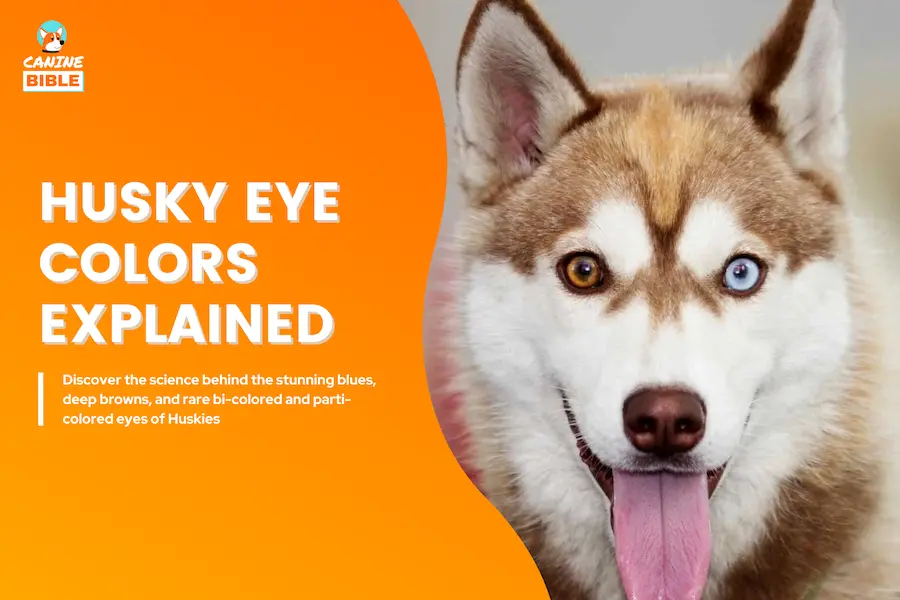Huskies With Brown Eyes vs Blue: Husky Eyes Explained

Canine Bible is reader-supported. We receive affiliate commissions via some of our links. This doesn’t affect rankings. Learn more.
This guide contains everything you need to know about huskies with brow eyes and how they differ from their blue-eyed counterparts. When you think of a Siberian husky, you think of a graceful, medium-sized dog with penetrating blue eyes. But can huskies have brown eyes? Yes. Brown is the most common eye color for dogs. Siberian Husky’s eyes can be either blue or brown. However, they can also have one eye, blue and the other brown, multiple colors in one eye, and even emerald eyes.
So, what is the big deal with brown-eyed huskies? Are blue-eyed huskies more prone to health problems? Can a purebred husky have brown eyes? Understanding the significance of eye color in Siberian Huskies is crucial for breed enthusiasts, prospective owners, and anyone captivated by these magnificent dogs. Let’s dive in.
The Significance of Eye Color in Huskies
The Siberian Husky is originally from Northeast Siberia. Huskies were bred by the Chukchi Eskimo people of northeastern Asia as endurance sled-pulling, guarding, and companionship dogs.
Historically, Siberian Huskies were bred by the Chukchi people of Siberia not only for their strength and endurance but also for their appearance, which was believed to reflect their capabilities and temperament. The striking blue eyes of some Huskies were often associated with the sky and spirituality, imbuing these animals with a sense of mysticism and value beyond their physical abilities.
Siberian Husky’s thick double coat and effortless capabilities for hauling light loads over vast expanses of the cold and harsh environments of the Siberian Arctic are traits of today’s Siberian Husky. After arriving in Alaska during the Nome Gold Rush in 1909, huskies appeared in the United States and Canada. Siberian Huskies gained notoriety in the early 1900s as sled-winning dogs. In 1925, Huskies made headlines for traveling 658 miles in only five and a half days to deliver medicine when a diphtheria epidemic broke out in the isolated town of Nome, Alaska. In 1938, the AKC founded the Siberian Husky Club of America. Huskies belong to the Spitz dog family and are known as Chukcha, Chuksha dog, Husky, or Sibe.
In modern times, the fascination with Husky eye color continues, often influencing perceptions of the breed. While all eye colors are equally accepted in breed standards for show dogs, some potential owners may have preferences based on aesthetics or misconceptions about behavior and health.
Husky Eye Color Rarity
We surveyed 365 Husky dog parents and found that only 145 out of 365 Huskies, or 39%, had blue eyes, highlighting the prevalence of this eye color within the breed. However, blue eyes are not universal among Huskies. A majority, 195 out of 365 or 53%, had brown eyes. The remainder of the Huskies had bi-colored eyes (4% or 16 Huskies) and parti-colored eyes (2% or 9 Huskies).
Reasons Huskies Develop Certain Eye Colors
Understanding the factors that determine Huskies’ eye color will help you understand why some have brown eyes, blue eyes, bi-colored eyes, or parti-colored eyes.
Genetics
Genetics is the most common factor that determines the eye colors of Huskies.
The ALX4 gene: A study published in the journal PLOS Genetics, which analyzed 6,000 dogs’ complete genetic profiles, found that a genetic change or mutation near a gene known as ALX4 is strongly associated with blue eyes in Siberian huskies.[1] The ALX4 is considered the primary gene responsible for blue eyes in Huskies. Huskies without this genetic mutation are more likely to develop brown eyes or a mix of brown and blue.
The Merle gene: This gene is responsible for pigment dilution (lightening) of the nose, eyes, and coat. The Merle gene could make a Husky more likely to have blue eyes, but it is not guaranteed they will. In breeds with the merle gene, it can lead to blue or odd-colored eyes due to how it dilutes pigment. The dominant merle gene M, which causes merle or double-merle coat patterns, is also more likely to cause blue eyes in dogs. Dogs with one, but especially two dominant copies of this gene are likely to have blue or at least partially blue eyes. Huskies with brown eyes may have the gene but never develop blue eyes.
Melanin Production
Besides genetics, another key factor influencing Husky eye color is melanin, a pigment in the iris. Typically, Huskies with more melanin in their iris tend to have brown eyes. The amount of melanin can vary greatly among dogs; the more melanin there is, the darker the eyes will appear, and the less melanin, the lighter the eyes will be.
Two main types of melanin affect a dog’s coloration: eumelanin, which is black or brown, and phaeomelanin, which is yellow or red. MC1R (Melanocortin 1 Receptor), known as the “Extension” gene, primarily determines whether an animal produces eumelanin or pheomelanin. Variants (or mutations) in this gene can switch the production between these two types of melanin. Certain genes, like the “M (merle) locus gene,” can modify eumelanin.[2] This modification can lead to a reduction in pigmentation, resulting in a variety of eye colors in Huskies, such as liver (brown), blue (greyish), or isabella (a pale brown).
Variations in melanin distribution and concentration can lead to eyes with more than one color (parti-colored) or one blue and one brown eye (heterochromia). These variations can be influenced by different genetic factors that affect how melanin is distributed in each iris or between both eyes.
Siberian Huskies Don’t Actually Have Blue Eyes
According to Geneticist Kristopher Irizarry of the College of Veterinary Medicine at Western University of Health Sciences, huskies don’t have blue eyes. The ALX4 gene mutation in Siberian huskies seems to decrease pigment production in the eye. The lack of pigment causes the eye to appear blue. “There’s no blue pigment. It’s about how the light enters and exits the eye, creating the appearance of blue, the same way the sky looks blue, but outer space is not blue,” says Irizarry.
Can Huskies Have Brown Eyes?
Yes, Huskies can have brown eyes. Brown is one of the most common eye colors in Siberian Huskies, alongside blue. Huskies’ brown eye color can range from light amber to deep, dark chocolate. The brown eye color in these dogs, as in most dogs, is due to melanin, the pigment that gives color to the skin, hair, and eyes. The higher the level of melanin in their iris, the darker the eyes.
The genetic basis for brown eyes in Huskies is dominant, meaning that if the genes responsible for brown eyes are present, they typically override genes for lighter eye colors. This is why brown is a more commonly observed eye color in the general dog population. However, what makes Huskies unique is their ability to have blue eyes. This trait is relatively rare in dogs and is controlled by genetic mechanisms different from those affecting most breeds.
In addition to having uniformly blue or brown eyes, Huskies can have bi-colored (one blue eye and one brown eye) or parti-colored eyes (eyes containing two different colors), showcasing the remarkable genetic diversity of this breed’s eye color traits.
Brown Husky With Blue Eyes
Can brown huskies have blue eyes? Yes, brown-coated (or any color) Siberian Huskies can have blue eyes. Brown Huskies with blue eyes are unique, and their chocolate-brown coats make their strikingly deep-blue eyes stand out even more.
The coat color of a Siberian Husky is not directly linked to their eye color. This means a Husky with a brown, black, white, gray, or any other coat color can potentially have blue eyes. The eye color in Siberian Huskies is primarily determined by genetics, specifically a mutation near the ALX4 gene on canine chromosome 18, which has been associated with the blue eye trait in this breed.
Brown-Eyed vs Blue-Eyed Husky Health Issues
Are brown-eyed Huskies less at risk of health issues than those with blue or other colored eyes?
Huskies can face several health challenges, including juvenile cataracts, corneal dystrophy, and progressive retinal atrophy, which are severe eye conditions that can occur in dogs of any eye color.
Another condition to be aware of is Uveodermatologic Syndrome, which primarily affects northern dog breeds. This syndrome targets melanocytes in the skin and eyes, leading to premature whitening of the hair, skin, and eyes, and can cause blindness. Brown-eyed Huskies have a higher concentration of melanin, which offers more protection against UV rays and some types of eye damage. On the other hand, Huskies with lighter eye colors, like blue or green, might have a slightly increased risk of certain conditions, including cancer, due to less melanin.
It’s important to note that Blue eyes are normal in Huskies and don’t usually indicate health problems. However, blue eyes can be a symptom of some traits affecting a dog’s health. For instance, Huskies with blue eyes caused by the merle gene could be at a higher risk of blindness and deafness, particularly when two merle genes are present (double merle).
Regular Health Checks & Care Tips For Huskies
Care tips for brown-eyed Huskies are similar to those for the breed. They focus on providing the best food for Huskies, plenty of exercise, and mental stimulation to keep them happy and engaged. Routine veterinary visits for vaccinations, parasite control, and overall health assessments are crucial for a long, healthy life.
Husky Eye Colors
The following husky eye color chart will show all the eye colors that Siberian Huskies can have.
Blue-Eyed Husky
Piercing blue eyes are a defining and most common trait of huskies. You may find huskies with darker blue eyes, while others may have a lighter blue eye coloration. A distinctive feature that is more prominent in blue-eyed huskies is a dark outline that surrounds the outside of their eyes.
Brown-Eyed Husky
Huskies with brow eyes are the second most common eye coloration in huskies. Their brown eyes are due to high levels of melanin and the possible absence of the merle gene. These colors range from dark brown to light hazel, which may look greenish.
Bi-Colored Eyed Husky
Bi-eyed Huskies or Huskies have different colors for each eye. These dogs are not as common as blue and brown-eyed huskies. Roughly 15% of Huskies have this characteristic. For instance, a bi-eyed Husky can have one eye blue and the other brown, as shown in the picture.
Green-Eyed Husky
Green eyes (or emerald-eyed) on huskies are uncommon but can occur. It usually happens when huskies transition from blue to brown. During this process, melanin isn’t sufficient to reach a brown tonality, thus staying in the green spectrum of colors.
Particolored-Eyed Husky
This is by far the rarest eye color variation in huskies. About 5% of huskies present this condition. Parti-eyed means when a Husky has two colors in the same eye (e.g., brown and blue). The shades of one color may be more prominent than the other. It usually happens in only one eye. So why does it happen? We explain below.
Grey Husky With Blue Eyes
White Husky Brown Eyes
Husky Puppies With Brown Eyes
Are husky puppies with brown eyes inferior to huskies with blue eyes? Are you concerned about the quality of your Siberian husky puppy with brown eyes?
No, Husky puppies with brown eyes are not inferior to those with blue eyes, and there’s no reason to be concerned about the quality of your Siberian Husky puppy if it has brown eyes. This is true unless you are aiming to raise a champion show dog. Even then, to assess the quality of your Siberian Husky puppy, you should refer to the breed standard set by the American Kennel Club (AKC). The AKC specifies that Siberian Husky eyes should be “almond-shaped, moderately spaced, and set slightly obliquely. The eyes may be brown or blue, one of each, or parti-colored. Eyes set too obliquely or close together are not acceptable in Huskies.” Therefore, Huskies with brown eyes are common and meet the breed standards. A significant number of high-quality Siberian Huskies have brown eyes or bi-colored eyes.
Eye Color in Husky Puppies
All husky puppies are born with blue eyes. As they grow older, their eyes develop more melanin pigment, which can result in them having two brown eyes, heterochromia, or parti-coloring. A Husky’s permanent eye color usually becomes visible at around 3 or 4 weeks of age. However, mature eye coloration in Husky puppies may take 12 to 16 weeks. Eye colors can range from brown to amber-green to the rare permanent blue color or even multicolored eyes.
Husky Puppies With Brown Eyes For Sale
When buying a husky puppy, be diligent. Make sure this breed fits your personality and your family’s lifestyle. Choose reputable and responsible breeders. The AKC MarketPlace is an excellent start to start your search and find husky puppies with brow eyes on sale in your area. When possible, always consider fostering and adopting. Online marketplaces like Pawrade and PuppySpot are recommended resources that offer pre-screened puppies from reputable U.S. breeders.
Characteristics of Blue-Eyed vs Brown-Eyed Huskies
Appearance
Blue-eyed Huskies share the same breed-specific traits and physical characteristics as their counterparts with different eye colors. These include a medium-sized build, erect triangular ears, almond-shaped eyes, and a bushy tail that often curls over their back. They possess a double coat consisting of a dense undercoat and a longer topcoat designed to protect them from harsh weather. This breed is known for its remarkable endurance and capability to perform well in cold environments. The Husky is a medium-sized working dog, quick and light on his feet, graceful in action, and with wolfish looks. Males can grow between 21-23.5 inches tall and 45-60 pounds. Females can be 20-22 inches tall and 35-50 pounds.
Personality-wise, Huskies are friendly, outgoing, and mischievous. They are known for their high energy levels and need for regular exercise. Despite their independent and sometimes stubborn nature, Huskies are generally good-natured, making them well-suited as family pets.
Temperament & Personality
Huskies are loyal, mischievous, and outgoing dogs. Originally born pack dogs, they are great companion dogs and enjoy family life. Huskies are high-energy dogs and can’t resist their instinct to chase small animals, so walking a Siberian Husky on a leash is always a good idea. Huskies are light on their feet, love baking outdoors, and run. Most Siberians are naturally clean, with little doggy odor. They tend to be super friendly and affectionate. Huskies are even-tempered and not always willing to please.
Intelligence
Canine psychologist Stanley Coren says huskies are “average” intelligent dogs. In Coren’s dog intelligence trials, Siberian Huskies ranked 74th out of 138 dog breeds for obedience & working intelligence. This husky intelligence research found that Huskies needed 25 to 40 repetitions to learn a brand-new command. Coren also found that huskies will obey known commands on the first try with a 50% or higher success rate.
However, their stubborn personality may have influenced these results. They are fully capable of understanding but not always willing to cooperate. Most husky owners on a survey said they are brilliant dogs.
Breeding Huskies With Brow Eyes
Ensure that female and male Huskies come from healthy bloodlines before breeding Huskies. Breeding Huskies with congenital or hereditary severe health issues is considered inhumane and strongly discouraged. Breeding brown-eyed Huskies is the same as those with other eye colors. A female should be at least two years old and have undergone her second heat cycle before breeding. It’s advisable not to breed female Huskies during two consecutive heat cycles to allow her adequate time for recovery. The expected litter size for Siberian Huskies ranges from 4 to 8 puppies, with 6 being the average number reported.
How to Check For Eye Color In Huskies
Never use a flashlight or anything of that nature to check a puppy’s eye color.
Frequently Asked Questions
Should You Get A Husky With Brown Eyes?
For good reasons, Huskies rank 12 on the American Kennel Club (AKC) list of most popular dog breeds. So, should you get a Siberian husky? The answer is yes if you can keep up with a super-active dog. Huskies have a lot of energy and require a lot of exercise. Remember, these dogs can pull sleds across hundreds of miles. If your lifestyle doesn’t match this level of physical activity, we strongly advise choosing a different dog breed. Huskies can develop behavioral problems caused by frustration and lack of physical activity.
Huskies are chatty, too. They tend to howl and make lots of noise. Siberians are social and regularly need the company of owners or dog friends. They are excellent household pets and are tolerant of children. They need supervision like all other dogs when around babies and small children. They are not suited for being alone all day. If you decide to get a husky, Siberian Huskies For Dummies answers are your go-to guide to understanding and raising a Husky.
Like It? Subscribe & Share!
Sources
Canine Bible uses only high-quality sources, including peer-reviewed studies, to support the facts within our articles. Read our editorial process and product review methodology to learn more about how we fact-check, test products, and keep our content accurate, reliable, and trustworthy.
Canine Bible authorship represents the unified voice of our entire editorial team and our in-house veterinarians rather than a single author. Each article, blog post, and review published under the Canine Bible name undergoes a rigorous review process, involving all team members to guarantee accuracy and up-to-date in accordance with the latest veterinarian research. This collaborative effort is an integral part of our editorial process and aligns with our four pillars of content creation. This approach ensures our content is backed by expert knowledge and factual information, offering our readers reliable, actionable, and trustworthy content.







